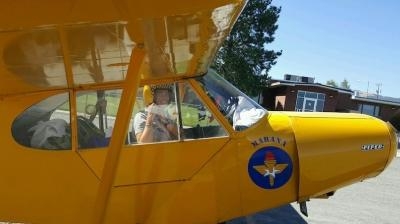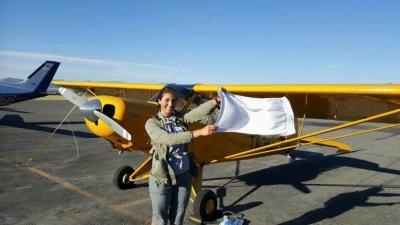Solo Trip To And From Oshkosh Was Exciting And Educational
By Maria Morrison
While the voyage to AirVenture in Oshkosh, Wisconsin is most commonly talked about in aviation circles, the trip home is equally trying. As a student pilot taking a Piper Cub across the country, I found that the trip home to Western Washington was made difficult due to headwinds, mechanical difficulties, and fatigue from the week.

Having spent the previous two weeks flying and working at AirVenture, I was fairly tired by the time I crawled back into my PA-18 Piper SuperCub. Well aware of this, I factored it into my safety checks. Flying for hours in the sun requires focus in order to not grow complacent and miss something. In flight I made sure to drink from the two water bottles I had and eat what I could pack easily in a freezer bag. On the ground, I remembered to rest and review my next leg of the trip to cut down on confusion in the air.
Prior to departing KOSH, I did a very thorough preflight of my 105 Special Cub. On that inspection I found that my primer line had broken. Luckily, I am good friends with the mechanics at the Kermit Weeks hangar on the other side of the field. I spent roughly half an hour taxiing from Warbirds to the Weeks hangar where I could do the repairs necessary. Although I could easily have flown without an operational primer, the open line was a concern. The problem was fixed within an hour and the airplane was soon ready to go.
With the few lost hours, I only made it to Minneapolis that Sunday night. My family and I enjoyed the large city and the attractions it has to offer, which included a vintage airplane museum at Anoka airport.
The next day we pressed on to Dickinson, North Dakota. While my family’s airplane stayed high, I chose to fly 1000 feet above the ground over the flat states, examining the countryside as I flew. Our fuel stop in Britton, North Dakota introduced us to some very nice people and interesting aircraft.

Since we don't plan our stops ahead of time, I was pleasantly surprised when the next overnight in Great Falls, Montana happened to align with the Montana State Fair. We decided to stay overnight in the city. However, the next day, winds were so strong that I could not taxi the Cub off the ramp. The taildragger wanted so badly to turn into the wind that I could not make the left turn necessary onto the ramp. We ended up waiting several hours for the winds, gusting in the high 30s, to die down so I could depart. I said a quick prayer as I lined up on the runway, pointing diagonally to be facing the wind as I rolled down the runway. The Cub picked up immediately with the strong gusts and I made my way across the foothills of the Rockies to Helena, where we stopped for the night. I could hardly turn off the runway at Helena with the winds, but managed to taxi safely, “flying” the cub all the way into the chocks.
On the last day, I moved across the Rockies early in the morning to avoid turbulence from the heat and stopped briefly in eastern Washington for fuel. As I taxiied into my home airport and stepped into our local diner, I was greeted by a round of applause from our friends. The last stretch over the Cascades, although slow, had not been too difficult.
My trip to and from AirVenture in Oshkosh took 43 hours total and was done entirely solo. Having flown 2,944 miles round trip, I have been made a much better pilot. I know how to better deal with weather complications, mechanical and electrical failures, and many different flight conditions. It has also given me a wonderful opportunity to see different parts of the country and meet many other people from around the world.
 ANN's Daily Aero-Term (04.24.24): Runway Lead-in Light System
ANN's Daily Aero-Term (04.24.24): Runway Lead-in Light System ANN's Daily Aero-Linx (04.24.24)
ANN's Daily Aero-Linx (04.24.24) Aero-FAQ: Dave Juwel's Aviation Marketing Stories -- ITBOA BNITBOB
Aero-FAQ: Dave Juwel's Aviation Marketing Stories -- ITBOA BNITBOB Classic Aero-TV: Best Seat in The House -- 'Inside' The AeroShell Aerobatic Team
Classic Aero-TV: Best Seat in The House -- 'Inside' The AeroShell Aerobatic Team Airborne Affordable Flyers 04.18.24: CarbonCub UL, Fisher, Affordable Flyer Expo
Airborne Affordable Flyers 04.18.24: CarbonCub UL, Fisher, Affordable Flyer Expo




